Super Mario World Method: Obstacle Series
This is the third lesson from the series on how to use the Super Mario World method when building your own levels in Super Mario Maker. In previous articles, we looked at ways to streamline gameplay elements in Mario Maker at such levels of content organization complexity as testing (low) and modulation (medium). If you have not had time to read them, you should do this, because this article is based on the material that was passed earlier.

Previous issues:
1. Creating levels using the Super Mario World method.
2. Super Mario World Method: Add-ons and Extensions.
')
This time we will talk about the highest level of complexity of organizing content - a series of obstacles. They are responsible for the specific type of skills required to complete a series of tests or levels. By understanding how the Super Mario World series of obstacles work, you can create the right load not only in your Super Mario Maker levels, but also in your own games.
I created a demo level in Super Mario Maker that uses 2 sets of obstacles: “moving objects” and “repeating opponents”. Here is what it looks like:
You can try to go through it yourself. Level ID: F7E5 0000 0125 6EF3.
To understand well how the series of obstacles work, we need to make a brief excursion into the history of video games.
The history of the creation of video games can be divided into 3 eras: arcade, composite and episodic games. I have more detailed work on this topic , but in this case we are only interested in the 2 first epochs, since they allow us to better understand the principle of creating games using the Super Mario method.
In arcade games like Space Invaders, Pac-Man or Galaga, the gameplay lined up in just a few variables. Their complexity grew as the number of opponents increased, their speed and frequency of attacks. All this refers to the quantitative extensions that we talked about in previous articles.
Quality add-ons acquired a modern look when Shigeru Miyamoto of Nintendo came up with an integral type of game. The composite game combines 2 genres, allowing the player to use the mechanics of one genre to solve problems of another.
Super Mario Bros, the first full-fledged composite game, combines the genres of action and platformer. Her example perfectly illustrates this principle: the player can solve tasks of the genre of action (defeat opponents), using the mechanics of platformer (jumping).
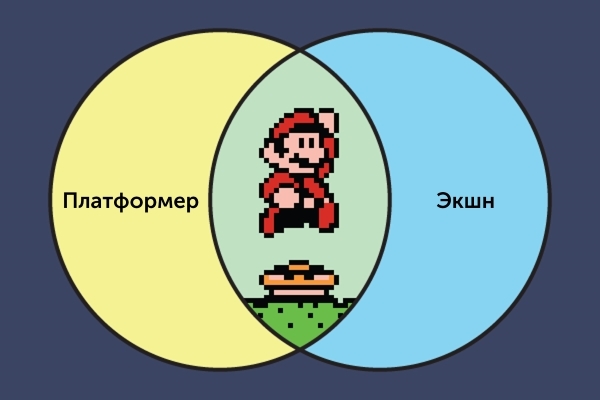
Games from the Super Mario Bros series combine elements of action and platformer
But this is not all: a real composite game must also constantly move from one genre to another, so that the gameplay does not annoy the player. This reciprocating movement keeps the players' attention and creates what I call the dynamics of the composite game.
Having dealt with theory, let's see how to apply this knowledge when working with Mario Maker. Well understanding the theory of composite games, you can easily figure out how to properly fill levels in Mario.
We found out that the Mario games combine elements of action and platformer. Each level of the game should be built primarily using the content of one of these genres. Accordingly, when creating a new level, the designer must first of all decide on the genre that will prevail. I repeat: this decision must be made at the very early design planning stage.
If we created platformers of the year in 1986, at this stage we would be able to proceed to the development. But since then the games have gone far ahead, become deeper and have acquired many features. Therefore, we need to decide on one more important detail that appeared due to the games of Mario - a set of target skills necessary for the game.
Starting with Super Mario World, Nintendo developers have created levels in such a way as to use different skills of players. They wanted to give them a new experience when passing through levels of a familiar genre. Since then, in the Super Mario World game, it is customary to single out 2 separate skill sets, one of which is responsible for timing, and the other for speed. Each of them is suitable for any of the two genres of the game.
The table below more clearly demonstrates this correspondence:
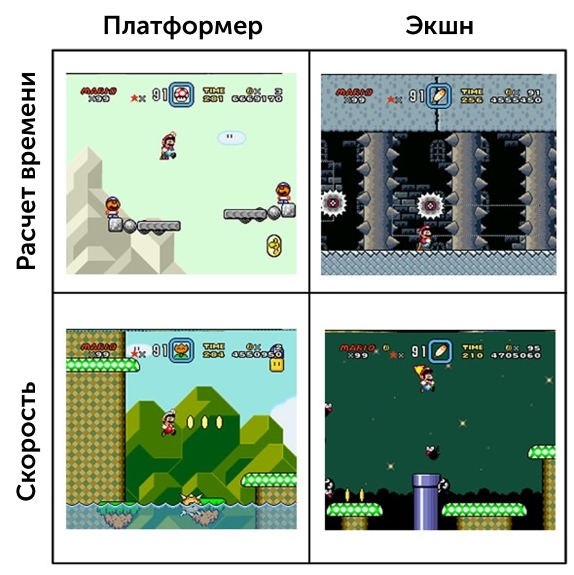
Each combination of genre and skill set creates a completely new type of level. These types belong to the highest level of content organization according to the principle of IMSP - a series of obstacles. One series of obstacles corresponds to a series of levels of a certain genre with a certain set of necessary skills.
In this lesson we will examine 2 series: “moving objects” and “repeating opponents”. Do not worry if you do not quite understand their meaning, then I will explain everything in detail with examples.
The first series of obstacles that we will talk about is “moving objects”. It can also be called “moving platforms” because it is based on the mechanics of the platformer and the timely execution of jumps. I used the word “objects”, since in Mario games, platforms often do not look like platforms: moving objects can be walls, barrels or opponents - but all of them can be designated by the collective concept of “object”.
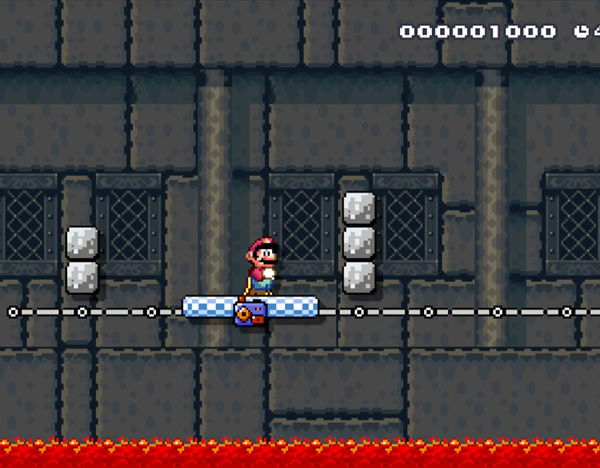
An example of a series of moving objects
Unlike "moving platforms", a series of repetitive opponents is based on the movement of opponents. Accordingly, now instead of Mario platforms, you need to overcome a number of opponents moving in a certain cycle.
The cycle of their movement need not be closed or circular. Any opponent moving at a fixed speed and along a fixed trajectory moves in cycles. The main thing is for the player to be obvious where and when the enemy will move, as is the case with the direction of movement of the platform.
Of course, this series of obstacles relates rather to the action genre, since the danger lies not in an unsuccessful jump, but in a collision with an opponent. If you look, see for yourself that many levels in Super Mario World, using a series of recurring opponents, almost do not require jumping.

An example of a series of repetitive opponents
In my level, as in most of the castles and fortresses of the Super Mario World game, the player runs more than jumps. Of course, there are also jumps here, but a series of repetitive opponents is built primarily on running at the right time, and for this sometimes you have to wait.
Of course, you can try to run all the Twomp and Grinders from the example above at full speed, but the trick is that it is quite difficult to do. If the player simply waits for the right moment, it will become much easier for him to cope with all the obstacles. It's all about timing and accuracy, not speed and reaction.
The key point when dealing with repetitive opponents is combining different cycles of movement of several opponents. By and large, you just need to combine several asynchronously moving obstacles or opponents in one test. For example, like this:
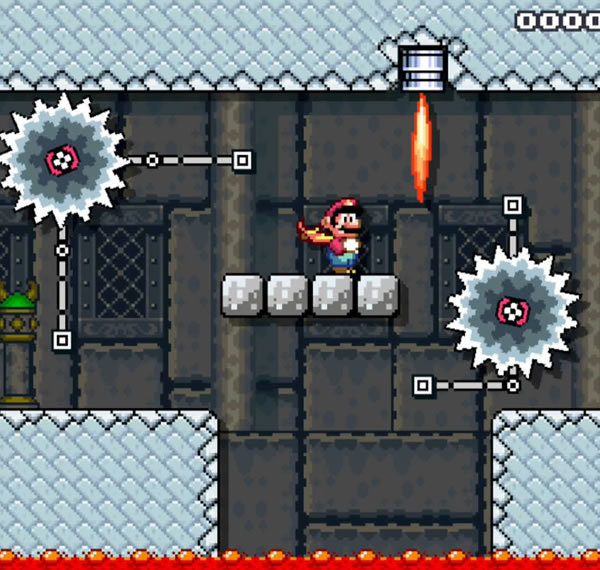
A more complex example of a series of repetitive opponents
The intervals at which the turbine releases a flame do not correspond to the intervals of motion of the Grinder. It turns out that each of them is dangerous at different times. So, the player must take into account these factors and calculate the right moment for a safe jump. The jump itself is not difficult, but it must be done at the right time.
After this, the transition ends, and the level returns to the series of moving objects. If you, as a level designer, want to clearly adhere to the formal style of Nintendo, pay special attention to this step. In Super Mario World (as in other Mario games) there are often levels with long transitions, but very few of them end with a series of obstacles. In our case, a return to a series of moving objects will further complicate the initial idea of separation from the platform.
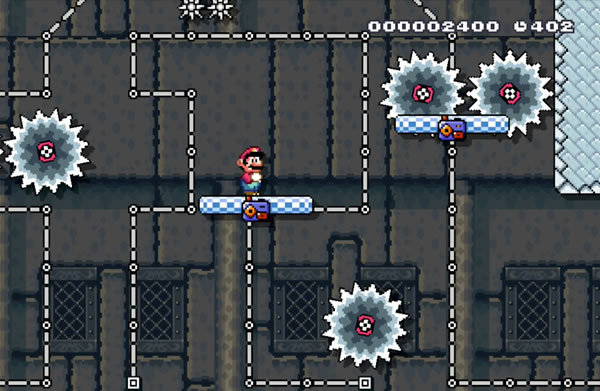
Now Mario is forced to move between moving platforms, almost as it did in Super Mario World at the Cheese Bridge or Way Cool levels. This part of the level is a bit shorter, besides, the Super Mario Maker functionality is limited and does not allow me to build something more grandiose and confusing at this stage - like what you could see in Super Mario World. However, in this part of the level, the player must calculate the movement time of the two platforms, and not the one, which is a completely logical addition.
Then I combine the 2 test series for the final test. Here we have both moving objects and repetitive opponents:
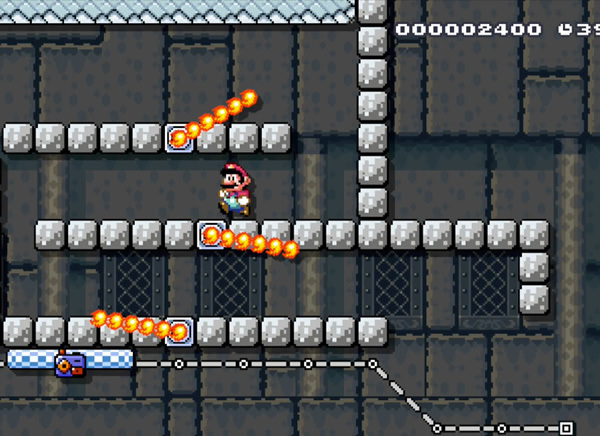
The player needs to jump off a moving platform, go through several repetitive traps and return to the platform again. All this is more or less clear even at first glance. I set up the rotation of the fire barriers so that you can quickly run through them, waiting only for a second next to each. You just need to perform 2 successful dashes and jump back to the moving platform when it passes under the lower row of stones.
Now you should be a little clearer how the series of obstacles work. The two that we reviewed today are far from the only ones in Super Mario World, and even more so in platformers. In the next article we will examine 2 other series of obstacles and talk about other games from Nintendo.
Here are the key points of this lesson:
I wish you good luck with the creation of your levels!

Previous issues:
1. Creating levels using the Super Mario World method.
2. Super Mario World Method: Add-ons and Extensions.
')
This time we will talk about the highest level of complexity of organizing content - a series of obstacles. They are responsible for the specific type of skills required to complete a series of tests or levels. By understanding how the Super Mario World series of obstacles work, you can create the right load not only in your Super Mario Maker levels, but also in your own games.
My example
I created a demo level in Super Mario Maker that uses 2 sets of obstacles: “moving objects” and “repeating opponents”. Here is what it looks like:
You can try to go through it yourself. Level ID: F7E5 0000 0125 6EF3.
To understand well how the series of obstacles work, we need to make a brief excursion into the history of video games.
A brief history of the creation of video games
The history of the creation of video games can be divided into 3 eras: arcade, composite and episodic games. I have more detailed work on this topic , but in this case we are only interested in the 2 first epochs, since they allow us to better understand the principle of creating games using the Super Mario method.
In arcade games like Space Invaders, Pac-Man or Galaga, the gameplay lined up in just a few variables. Their complexity grew as the number of opponents increased, their speed and frequency of attacks. All this refers to the quantitative extensions that we talked about in previous articles.
Quality add-ons acquired a modern look when Shigeru Miyamoto of Nintendo came up with an integral type of game. The composite game combines 2 genres, allowing the player to use the mechanics of one genre to solve problems of another.
Super Mario Bros, the first full-fledged composite game, combines the genres of action and platformer. Her example perfectly illustrates this principle: the player can solve tasks of the genre of action (defeat opponents), using the mechanics of platformer (jumping).

Games from the Super Mario Bros series combine elements of action and platformer
But this is not all: a real composite game must also constantly move from one genre to another, so that the gameplay does not annoy the player. This reciprocating movement keeps the players' attention and creates what I call the dynamics of the composite game.
How does this relate to level design?
Having dealt with theory, let's see how to apply this knowledge when working with Mario Maker. Well understanding the theory of composite games, you can easily figure out how to properly fill levels in Mario.
We found out that the Mario games combine elements of action and platformer. Each level of the game should be built primarily using the content of one of these genres. Accordingly, when creating a new level, the designer must first of all decide on the genre that will prevail. I repeat: this decision must be made at the very early design planning stage.
If we created platformers of the year in 1986, at this stage we would be able to proceed to the development. But since then the games have gone far ahead, become deeper and have acquired many features. Therefore, we need to decide on one more important detail that appeared due to the games of Mario - a set of target skills necessary for the game.
Starting with Super Mario World, Nintendo developers have created levels in such a way as to use different skills of players. They wanted to give them a new experience when passing through levels of a familiar genre. Since then, in the Super Mario World game, it is customary to single out 2 separate skill sets, one of which is responsible for timing, and the other for speed. Each of them is suitable for any of the two genres of the game.
The table below more clearly demonstrates this correspondence:

Each combination of genre and skill set creates a completely new type of level. These types belong to the highest level of content organization according to the principle of IMSP - a series of obstacles. One series of obstacles corresponds to a series of levels of a certain genre with a certain set of necessary skills.
In this lesson we will examine 2 series: “moving objects” and “repeating opponents”. Do not worry if you do not quite understand their meaning, then I will explain everything in detail with examples.
Applying theory in Mario Maker
The first series of obstacles that we will talk about is “moving objects”. It can also be called “moving platforms” because it is based on the mechanics of the platformer and the timely execution of jumps. I used the word “objects”, since in Mario games, platforms often do not look like platforms: moving objects can be walls, barrels or opponents - but all of them can be designated by the collective concept of “object”.

An example of a series of moving objects
Unlike "moving platforms", a series of repetitive opponents is based on the movement of opponents. Accordingly, now instead of Mario platforms, you need to overcome a number of opponents moving in a certain cycle.
The cycle of their movement need not be closed or circular. Any opponent moving at a fixed speed and along a fixed trajectory moves in cycles. The main thing is for the player to be obvious where and when the enemy will move, as is the case with the direction of movement of the platform.
Of course, this series of obstacles relates rather to the action genre, since the danger lies not in an unsuccessful jump, but in a collision with an opponent. If you look, see for yourself that many levels in Super Mario World, using a series of recurring opponents, almost do not require jumping.

An example of a series of repetitive opponents
In my level, as in most of the castles and fortresses of the Super Mario World game, the player runs more than jumps. Of course, there are also jumps here, but a series of repetitive opponents is built primarily on running at the right time, and for this sometimes you have to wait.
Of course, you can try to run all the Twomp and Grinders from the example above at full speed, but the trick is that it is quite difficult to do. If the player simply waits for the right moment, it will become much easier for him to cope with all the obstacles. It's all about timing and accuracy, not speed and reaction.
The key point when dealing with repetitive opponents is combining different cycles of movement of several opponents. By and large, you just need to combine several asynchronously moving obstacles or opponents in one test. For example, like this:

A more complex example of a series of repetitive opponents
The intervals at which the turbine releases a flame do not correspond to the intervals of motion of the Grinder. It turns out that each of them is dangerous at different times. So, the player must take into account these factors and calculate the right moment for a safe jump. The jump itself is not difficult, but it must be done at the right time.
After this, the transition ends, and the level returns to the series of moving objects. If you, as a level designer, want to clearly adhere to the formal style of Nintendo, pay special attention to this step. In Super Mario World (as in other Mario games) there are often levels with long transitions, but very few of them end with a series of obstacles. In our case, a return to a series of moving objects will further complicate the initial idea of separation from the platform.

Now Mario is forced to move between moving platforms, almost as it did in Super Mario World at the Cheese Bridge or Way Cool levels. This part of the level is a bit shorter, besides, the Super Mario Maker functionality is limited and does not allow me to build something more grandiose and confusing at this stage - like what you could see in Super Mario World. However, in this part of the level, the player must calculate the movement time of the two platforms, and not the one, which is a completely logical addition.
Then I combine the 2 test series for the final test. Here we have both moving objects and repetitive opponents:

The player needs to jump off a moving platform, go through several repetitive traps and return to the platform again. All this is more or less clear even at first glance. I set up the rotation of the fire barriers so that you can quickly run through them, waiting only for a second next to each. You just need to perform 2 successful dashes and jump back to the moving platform when it passes under the lower row of stones.
Summing up
Now you should be a little clearer how the series of obstacles work. The two that we reviewed today are far from the only ones in Super Mario World, and even more so in platformers. In the next article we will examine 2 other series of obstacles and talk about other games from Nintendo.
Here are the key points of this lesson:
- Many classic video games combine 2 or more genres.
- Deviation in the direction of one or another genre from level to level will allow you to refresh the gameplay of your game. But remember: in no case should not completely abandon any of the genres underlying your game.
- Along with the genres in the game, you can alternately change target skills, such as timing or speed, solving problems, or conducting combat.
- Most levels of the Super Mario World game use a series of tests that combine the mechanics of a certain genre and a certain skill.
- As a rule, when a change in a series of tests occurs within the same level of a Super Mario World game, the genre changes, not the target skill. The transition from one genre to another within the same level is quite possible. But changing the required skill within the same level is unacceptable. For example, the level that requires the skill of calculating time, can not turn into one where you need to overcome obstacles to speed.
I wish you good luck with the creation of your levels!
Source: https://habr.com/ru/post/309522/
All Articles